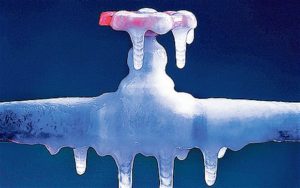 For Canadian residents, we don’t hibernate in the winter like a bear. We get up and go to school & work every day – life goes on no matter how cold it gets. So we need everything in our home to work, even when the temps are below-freezing.
For Canadian residents, we don’t hibernate in the winter like a bear. We get up and go to school & work every day – life goes on no matter how cold it gets. So we need everything in our home to work, even when the temps are below-freezing.
And that means when ice sneaks its way into places we don’t want it, like on our roof or in the drain and water pipes, we have to take action. However, the action we take must be well thought out and as such, it is best to call a professional. The Arctic temperatures freeze the ground and that, unfortunately, freezes the pipes below the ground, causing the need for water line repair or replacements when the ground thaws.
You Can Prevent Frozen Pipes!
The best thing to do is to protect your home’s plumbing from the frigid weather before winter arrives. This is the best way to avoid plumbing problems and we offer the following tips:
- Keep your home’s interior warm. The indoor thermostat should never be lower than 55 degrees. Open all the cabinet doors at the bath and kitchen sinks so that warm air can get to the pipes.
- Remove all of your garden hoses and insulate all of the exterior faucets. If there is an exterior shut-off valve around your home, close it up. Make sure all the outdoor pipes are drained completed of water.
- Keep a regular check on all the water drains to make sure they are draining thoroughly. A clogged drain is likely to freeze up.
- Insulate all exposed pipes, especially in areas that are unheated like your basement.
- Leave faucets dripping when the outside temps are extreme cold. Moving water isn’t as prone to freezing and if it does freeze, the pressure is reduced when left open, which prevents the pipes from bursting. Repairing small diameter sewer and drain pipes are the most common job for plumbers in the winter months.
- Drain the water system at unoccupied homes – If you have a second home, cabin, or other property that remains unoccupied for extended periods turn the water off at the main cut-off valve and drain all lines.
If Your Pipes Do Freeze
If you turn the faucet knob and no water flows, you most likely have frozen pipes. If it has been a short time, it most likely just froze up. Leave the faucet knobs turned on, aka open, and make sure the cabinet door below is open.
If it has been a while since you last turned the water on, you could have extensive damage already and the best thing you can do is call a professional plumber. While waiting for the plumber, make sure all the water is turned off to the house, starting at the main shut-off valve. Be sure all faucets are turned in on position to open them. This is necessary so that when the pipes are thawed, the water can flow on through, relieving any pressure that has built up.
